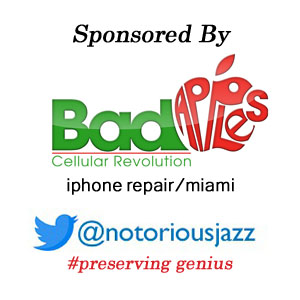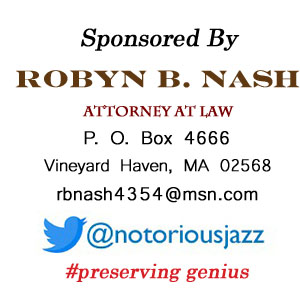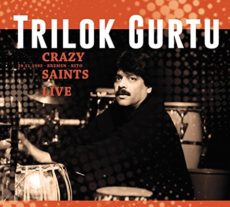
Daily Dose Of Jazz…
Trilok Gurtu was born in Mumbai, India on October 30, 1951 to Hindu Brahmin parents and attended Don Bosco High School. His mother, singer Shobha Gurtu, encouraged him to learn playing tabla, and he studied playing the instrument under Shah Abdul Karim. He didn’t begin playing western drum kit in the 1970s and developed an interest in jazz, and played played with Charlie Mariano, John Tchicai, Terje Rypdal, and Don Cherry.
One of Trilok’s earliest recordings was around 1977 in the record Apo-Calypso in an album of the German ethnic fusion band, Embryo. His mother also sang in that record, and later joined him in his first solo CD, Usfret. In the 1980s, Gurtu played with Swiss drummer Charly Antolini, John McLaughlin, Jonas Hellborg, Kai Eckhardt, Dominique DiPiazza and opened for Miles Davis in Berkeley, California in 1988. He went on to play and record three albums with Oregon after the death of drummer Collin Walcott. In the early 1990s he resumed his career as a solo artist and a bandleader.
In 1999, Zakir Hussain and Bill Laswell founded a musical group, Tabla Beat Science, bringing Trilok, Karsh Kale and Talvin Singh into the fold. Before going dormant in late 2003 they released three albums. He went on to record the album, Miles Gurtu, with Robert Miles, collaborate with the Arkè String Quartet and perform with Ricky Portera, Nick Beggs, Mario Marzi, Terl Bryant, John De Leo.
Percussionist, drummer and composer Trilok Gurtu has won awards from DRUM! Magazine, Carlton Television Multicultural Music Awards, Down Beat’s Critics Poll and has been nominated for the BBC Radio 3 World and continues to perform, compose, record and tour.
More Posts: drums,percussion,tabla
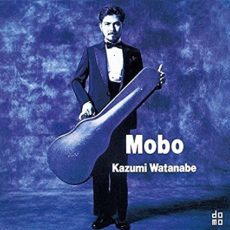
Daily Dose Of Jazz…
Kazumi Watanabe (渡辺香津美) was born on October 14, 1953 in Tokyo, Japan. He learned to play the guitar at the age of 12 from Sadanori Nakamure at the Yamaha Music School in Tokyo. He released his debut album as a leader at the age of 18 in 1971. By 1979, he had put together a jazz rock band with some of Japan’s leading studio musicians, and recorded the album Kylyn. The same year, he toured with the pop band Yellow Magic Orchestra.
The 1980s saw him touring as guest soloist with different groups – Steps, the Brecker Brothers, and Word of Mouth, led by Jaco Pastorius. Watanabe created the jazz-rock/jazz-fusion band Mobo in 1983 with saxophonist Mitsuru Sawamura, pianist Ichiko Hashimoto, Gregg Lee on guitar, Shuichi Murakami on drums, and Kiyohiko Senba.
During the eighties Kazumi also released the jazz-rock albums To Chi Ka (1980), Mobo Club (1983) Mobo Splash(1985), and Spice of Life (1987). A DVD was issued from the tour which featured drummer Bill Bruford and bassist Jeff Berlin, who also played on the record.
In the 1990s Kazumi assembled an all-Japanese line-up called Resonance Vox with Vagabonde Suzuki on bass, Rikiya Higashihara on drums and Tomohiro Yahiro on percussion, releasing several adventurous fusion albums. Over his career he has released four dozen albums as a leader, four DVDs of live performances and has worked with numerous musicians such as Lee Ritenour, Steve Gadd, Tony Levin, Jeff Berlin, Bill Bruford, Sly and Robbie, Wayne Shorter, Patrick Moraz, Marcus Miller, Richard Bona, and Peter Erskine.
Since 1996, he has been a visiting professor of music at Senzoku Gakuen College and has been chosen Best Jazzman 24 years in a row by Swing Journal magazine’s annual poll. Jazz fusion guitarist Kazumi Watanabe continues to perform, record, tour and teach.
More Posts: guitar
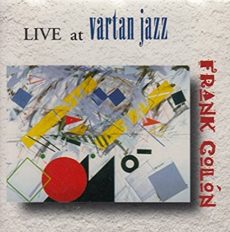
Daily Dose Of Jazz…
Frank Colón was born October 13, 1951 of Puerto Rican descent in Washington, D.C. but moved to Puerto Rico with his parents at the age of five. His musical instruction began at age eleven, beginning with classical piano lessons, under the guidance of Angelina Figueroa and Rafael Figueroa, both members of Puerto Rico’s most prestigious classical music family.
Colón kept up his piano studies throughout his teenage years, trying his hand at pop guitar, electric bass, and trap drums, as well as being very active in municipal and collegiate sports, martial arts, and amateur theater. Throughout this period in his life he worked with various local pop music groups throughout the island of Puerto Rico.
Moving back to Washington, D.C. in 1970 he attended college at American University, where Frank majored in Political Science. During this time, his musical orientation changed from melodic instruments to percussion and upon completion of his university requirements, he turned full-time to his music.
In 1976, Colón moved to New York City, on a call to work with his friend and mentor, the legendary drum master, Julito Collazo. Through Julito’s guidance, he became proficient at playing the Batá drums, sacred to the Orisha in the Santería religion.He has played Brazilian percussion since the time he lived in Washington, D.C.
Frank was performed and recorded with The Manhattan Transfer, Wayne Shorter, Weather Report, Mary J. Blige, Harry Belafonte, Gato Barbieri, Chet Baker, Pat Metheny, Aretha Franklin, Herbie Hancock, Gilberto Gil, Larry Coryell, Jimmy Smith, Milton Nascimento, Tania Maria, Ernie Watts, Paquito D’Rivera, Dave Valentin, Jon Lucien, João Bosco, Michael Wolff, Billy Taylor, Gal Costa, Dianne Reeves, Michel Camilo, Nestor Torres, Felix Cavalieri, Airto, and George Benson, among numerous others..
Percussionist Frank Colón has released two albums as a leader and continues to perform, record and tour.
More Posts: percussion
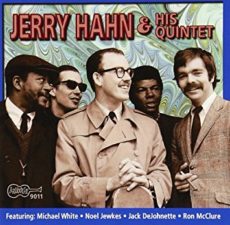
Daily Dose Of Jazz…
Jerry Hahn was born on September 21, 1940 in Alma, Nebraska and began playing the guitar at age 7. By 11 he was playing professionally with the Bobby Wiley Rhythmaires, appearing daily on Wichita’s first television station, KEDD.
He went on to study music at Wichita State University. Moving to San Francisco, California in 1962, he played with John Handy in 1964 and recording a live album with him at the Monterey Jazz Festival in 1966, then toured with the 5th Dimension in 1968 before joining Gary Burton in 1968 with Roy Haynes and Steve Swallow, With Burton he recorded three albums and toured the United States, Europe, Canada and Japan.
He began his recording career with his debut album Ara-Be-In as a leader in 1967 and led the Jerry Hahn Brotherhood in 1970, a country-blues jazz-rock ensemble, that was one of the trailblazers of the jazz-rock movement. In 1972, Jerry went back to Wichita, Kansas, where he became a full-time member of the Wichita State University faculty and established the degree program in jazz guitar.
1986 saw him relocating to Portland, Oregon where he joined the Bennie Wallace Quartet, recording and touring the United States, Europe and Japan. In 1992 he moved to Denver, Colorado, where he taught at the Colorado Institute of Art and in 1995 Jerry returned to Portland and joined the faculty of Portland State University and developed the curriculum for the Jazz Guitar program.
Jerry wrote a five-year monthly column for Guitar Player magazine titled Jerry Hahn’s Guitar Seminar, penned The Jerry Hahn Method for Jazz Guitar, published by Mel Bay Publications in 2003 and can also be heard on the movie sound track for White Men Can’t Jump.
He has recorded eight albums as a leader and over the years has been seen working with Michael White, Jack DeJohnette, Noel Jewkes, Ron McClure, Paul Simon and Ginger Baker among others. Guitarist Jerry Hahn is a contributor to the emerging fusion movement and continues to conduct clinics and work on new publications and recordings.
More Posts: guitar
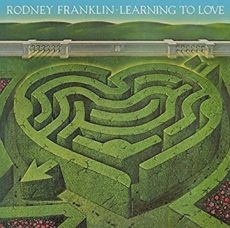
Daily Dose Of Jazz…
Rodney Franklin was born on September 16, 1958 in Berkeley, California and at the age of six he took jazz piano lessons at Washington Elementary School. He was taught by Dr Herb Wong who was a jazz journalist, disc jockey and music teacher.
Influenced by McCoy Tyner, George Duke, Chick Corea and Lonnie Liston Smith he would develop his own sound. Franklin worked with John Handy in San Francisco, California as well as Bill Summers, Freddie Hubbard and Marlena Shaw. He recorded his debut album in 1978 In The Center on the CBS label at age of 20.
1980 saw the release of the album You’ll Never Know which garnered some major chart success and additional six albums were albums were recorded for CBS during the Eighties and worked with bassist Stanley Clarke. Though Rodney gained some notoriety in the United States he was much more popular in the United Kingdom.
Moving to the BMG record label in 1988 he recorded Diamond Inside Of You, introducing vocals by Jennifer Holliday, who would go on to find fame on Broadway in Dreamgirls. By the Nineties he produced and released one album on the Nova label, however, pianist Rodney Franklin continues to composer and work in various music genres in and out of jazz.
More Posts: piano





